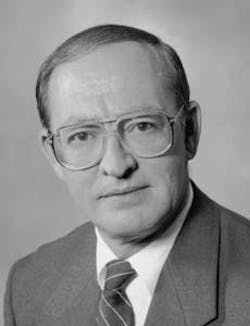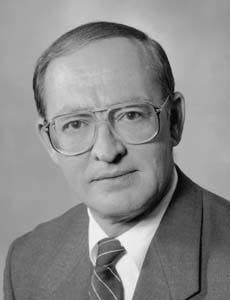TECHNOLOGY New salt product dries distillate streams, eliminates haze
Jack W. Barnett
General Chemical Corp.
Parsippany, N.J.
A new formulation of calcium chloride has proven effective at drying distillate streams in commercial refineries.
The product can be used at lower temperatures than rock salt, increasing its drying effectiveness. In addition, the problem of bridging, commonly associated with calcium chloride dryers, is eliminated.
Three case studies illustrate the product's uses and benefits.
Salt drying
For many years, refiners have used rock salt (sodium chloride) and calcium chloride to dry distillate and cracked product streams. It is generally recognized that rock salt will reduce product haze point to 15o to 20o F. below the operating temperature of the salt dryer.1
The major limitation of rock salt is that it will remove only insoluble or free-water haze from these process streams.
As a rule, steam-stripped hydrocarbon streams are fully saturated when they are pumped from a stripping tower. Water solubility in hydrocarbon decreases, however, with decreasing temperature (Fig. 1 [61702 bytes]).
Because of this relationship, it is important to cool the product stream as much as possible before it is processed through a salt dryer. This is why most salt dryers are designed to operate in a temperature range between 90o and 100o F. The lower operating temperature allows as much water as possible to come out of solution prior to drying.
Unlike rock salt, calcium chloride is hygroscopic. It has the capability to remove both soluble and insoluble water from treated hydrocarbon product streams. As a result, haze point reductions of 20o F. or more, below the levels achievable with rock salt, are possible with calcium chloride.1
Like sodium chloride, calcium chloride can have some limitations with regard to distillate drying. The most commonly reported problem is bridging.2
Bridging is the fusing of the calcium chloride in the vessel. This can result in uneven hydrocarbon flow and channeling through the vessel. The problem has been reported with both the pellet and flake forms of calcium chloride.
Reformulation
General Chemical Corp. has worked with several refiners in Canada during the past 5 years to develop a treatment program that minimizes the limitations of using calcium chloride for drying, while preserving its benefits.
The bridging problem was overcome by reformulating the product. The new product, designed specifically for refinery distillate and LPG drying, is called Cal-Dry.
Seven refineries in Canada are using the formulation. There has been no evidence of bridging at any of these plants since switching to the new product.
Cal-Dry calcium chloride can reduce or eliminate problems with distillate haze caused by high throughput rates or excessive salt-dryer temperature and further cooling in storage.
The product contains a very small amount of residual calcium hydroxide, which raises the pH and reduces the corrosion tendency of the brine produced in the dryer.
The pH profile for brine at various concentrations is:
- 40.0% CaCl2, pH 8.6
- 30.5% CaCl2, pH 9.3
- 20.5% CaCl2, pH 9.9
- 10.3% CaCl2, pH 10.3.
Even though the solutions show a relatively high pH, they have little actual acid neutralization value, because of the small amount of calcium hydroxide in the product.
Unit design
Most refiners use upflow salt dryer designs. The units are generally operated with a maximum average upward velocity of less than 10 in./min. Heavier, more viscous stocks require that average upward velocity be reduced to about 6 in./min.
The inlet of the distribution system should be designed to ensure uniform plug flow up the vessel through the salt bed.
The salt bed in the vessel usually is supported by gravel. General Chemical has found that salt crystal precipitation or fouling in the gravel bed can be eliminated by placing a 2-in. layer of sand on top of the gravel prior to charging Cal-Dry in the vessel.
Diesel haze
A refinery in northern Canada was having problems achieving haze specifications for straight-run diesel because of excessive water carryover in the product stream.
The refinery processes a blend of Forcados and Egyptian crudes. The crude unit normally runs 160,700 b/d of crude. It produces 10,500 b/d of 32o API diesel fuel during the summer and home heating oil during the winter months. A simplified diagram of the unit is shown in Fig. 2 [57701 bytes].
Drying using rock salt produced a hazy product, routinely creating problems meeting haze specifications. The refinery installed a second salt dryer to attempt to alleviate the problem.
When this did not solve the problem completely, the refiner filled the second vessel with 24 tons of the new calcium chloride formulation.
Both dryers are 12 ft ID x 21 ft 8 in. tangent-to-tangent (T-T) upflow units. The first dryer is filled with 46 tons of rock salt, which removes insoluble condensed water from the straight-run distillate stream.
The influent and effluent of both dryers were tested for total water content (both soluble and insoluble) by the Karl Fischer method (Fig. 2 [57701 bytes]). The test was run while the units were processing 10,710 b/d of diesel fuel.
Diesel from the atmospheric tower was cooled to 80o F. before it entered the first-stage dryer. This stream contained 1,040 ppm of total water. The stream was hazy and contained an extremely stable water emulsion.
The first-stage salt dryer comprised a bed of rock salt 13 ft deep. Processing the diesel through this dryer reduced the total water content in the fuel to 91 ppm.
The residence time in the rock-salt stage of the vessel is 36.7 min. After treatment in this stage, the diesel was slightly turbid in appearance.
The stream was then transferred to the second dryer. Treatment in this vessel produced a clear and bright product, with a total water content of only 53 ppm.
Even though the two vessels are the same size, the units are not filled with the same amount of salt. The bed depth in the second unit is only about 7 ft.
At a feed rate of 10,710 b/d, diesel contacts the salt in the second dryer for only 19.2 min. This is sufficient to dehydrate the fuel.
Since this refiner filled its second dryer with the new salt formulation, it has experienced no problems meeting product haze specifications. The diesel and home heating oil products are clear and bright.
Heating oil, LCO
A second refiner uses salt dryers to treat straight-run distillates and light cycle oil (LCO). All of the dryers in the refinery are two-stage units.
During the winter of 1993, the refinery was experiencing problems with haze in its heating oil. Historically, haze has been a problem for this refiner during winter be cause of high rates of fuel oil production.
The heating oil is a blend of kerosine and diesel from the atmospheric crude tower. A typical winter production rate from the unit is 15,720 b/d.
The drying system comprises a packed coalescer, followed by two 12 ft ID x 21 ft T-T salt towers. The temperature of the drying towers generally is maintained at about 80o F. during the winter.
At a production rate of 15,700 b/d, the average vertical velocity in the dryers is 6.5 in./min, and each dryer has a residence time of about 40 min. This is within normal design criteria for a heating oil drying tower.
According to the refiner, the water content in the inlet of the first salt dryer averages between 400 and 600 ppm. The first dryer reduces the stream's water content to 200-400 ppm.
The refiner reported that the finished product was developing a haze problem when its water content exceeded 100 ppm.
Both dryers and the brine effluent lines are made of carbon steel. Salt is supported in the dryers with gravel. A layer of sand is spread above the gravel.
In December 1993, the refiner replaced the rock salt in the second salt dryer with Cal-Dry. This corrected the haze problem. The modified unit configuration is shown in Fig. 3 [75194 bytes].
The refiner recently expanded the program to a second dryer processing an LCO stream from the fluid catalytic cracking unit. This is a two-stage dryer processing an average of 5,600 b/d LCO.
The dryers are 8 ft ID x 25 ft T-T upflow vessels. At 5,600 b/d, the average vertical velocity in the units is 5.2 in./min.
Like the crude unit dryers, the first stage is a rock salt dryer and the second-stage unit is filled with the new product.
The refiner reports that the program has been successful. There is no evidence of bridging in the salt bed. In addition, the brine effluent lines, which are steam traced, have not experienced fouling or evidence of corrosion problems since the change-out in both dryers.
Blending stocks
A third refiner salt dries two middle distillate streams produced in the atmospheric distillation unit. The streams are Merox-treated, water-washed, and processed through three salt dryers before being sent to storage.
In 1989, the salt dryers were switched from rock salt to Cal-Dry to improve water removal rates from both streams.
A kerosine-boiling-range stock is processed through parallel dryers. One dryer is a 10 ft ID x 17 ft T-T vessel.
This unit processes up to 8,900 b/d. It normally operates in a temperature range of 80-100o F. At maximum processing rates, the average vertical rise in the vessel is 5.3 in./min, and the hydrocarbon has a residence time of 38.5 min.
The second unit processes as much as 5,300 b/d of the kerosine-range feed. This dryer is a 10 ft ID x 16 ft T-T upflow vessel. The rate of vertical rise in the unit is 3.2 in./min and the vessel has a residence time of 60.8 min under reported flow conditions.
The third system processes a straight-run, light atmospheric gas oil (AGO) stream. Like the kerosine dryers, this dryer operates in a normal temperature range of 80-100o F.
The unit is a 11 ft ID x 22 ft T-T vessel. At maximum flow rates, the unit processes 11,520 b/d. Under these conditions the average vertical velocity in the vessel is 5.7 in./min.
During 1992, the units were charged with the reformulated CaCl2 product. The product was added to the units by topping off the salt level in the dryers two or three times per year.
Late in 1993, the refiner started noting a slight reduction in the performance of the dryers. The units were shut down, the gravel support bed was replaced, and a layer of sand was installed above the gravel. Fig. 4 [45934 bytes] illustrates how the refinery installed the support media.
The refinery has operated more than 10 months since the support media was replaced. The dryers are reported to be operating more efficiently, and the usage rate of the CaCl2 has decreased in all three units.
References
1. Transcript, National Petroleum Refiners Association Question & Answer Session on Refining and Petrochemical Technology, 1980, p. 14.
2. Brown, R.L., and Wines, T.H., "Improve Suspended Water Removal from Fuels," Hydrocarbon Processing, December 1993, pp. 95-100.
The Author
Jack W. Barnett is director of business development for General Chemical Corp., Parsippany, N.J. He is responsible for new program and product development for the soda ash, fine chemicals, water treatment, sulfuric acid services, and calcium chloride business groups.Barnett also was general manager of General Chemical's sulfuric products group, which operates three sulfuric acid regeneration plants.
Before joining General Chemical, Barnett worked in various sales and marketing management positions for 17 years in refining, process chemicals, and electrostatic-treating equipment for Nalco Chemical Co. and Petrolite Corp. He has a BBA from the University of Houston.
Copyright 1996 Oil & Gas Journal. All Rights Reserved.

